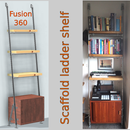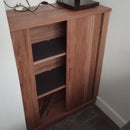Introduction: Sliding Ring Box
My last ring box I made I posted on Instructables and I got a lot of views and likes (ring box), also someone saw the wooden hinge I'd used and decided to put it on an engagement ring box he was making so when I decided to make another one I thought I'd put it on here too and hopefully it too could be an inspiration to others.
I have made quite a few wooden boxes now and one of them was similar to a drawer....so a box within a box and you pull the inner box out. Expanding on this idea I thought that a wholly contained box within a box would look pretty cool idea, with the outer box being constructed in two halves with would pull out revealing the inner box.
I sketched a few ideas out and originally I was going to make it quite a large box, say 300mm x 200mm x 200mm, which opened up as described above. I had a look at the wood I had to hand and was just a little short of what I'd need to make a large box. I therefore decided to make a small ring box as I had quite a few small planks I'd bought off ebay as off-cuts which were 50mm wide (2") and 10mm thick (approx 3/8").
Materials
Beech wood - dimensions as above. I only used an 800mm length
Walnut veneer - a very small amount
2No 3mm magnets
Leather to line the bottom.
Glue - i used Titebond III
Tools
Table saw
Router
Handsaw
Various clamps
Craft knife to trim the veneer
Step 1: Outer Box
I started by planing and thicknessing my planks. I made one plank around 10mm thick, for the outer box and another around 7mm thick for the inner box. Once planed I ripped the plank for my outer box to around 50mm then set my table saw blade to 45 degrees and cut fillets to either side of the plank. I then cut four sections from this plank to make the sides of my boxes.
Before gluing them together I need to create a couple of channels (dados) in to the bottom piece as I was going to place the inner box on runners to keep the boxes in line with each other. The easiest way to do this is on a router table but could be done other ways with a little more thought. To make the channels parallel I just cut one side and then flipped the piece round with the same setting on the router fence.
Once the channels had been cut I glued each of the joints and used decorators blue tape to 'clamp' the box together. I have done this a few times now and it seems to work really well and can be better sometimes than clamps as the joints don't slip against each other as they can do when tightening up the clamps.
Step 2: Inner Box
With the outer box frame complete I now had the measurements I needed for the inner box. I ripped the wood slightly larger than the internal measurements of the outer box so I had enough extra for sanding but still ensuring a nice fit.
As this box had an open top I used the same method with the tape as I did for the outer box but didn't add glue to the top joints. This would give me a nice square box without any complicated measurement or additional jigs etc. Once the glue had set I just removed the tape and the top piece came off giving me a U-shaped frame.
I then glued on two end pieces and sanded the outside of the box until I was happy with the general fit with the outer box.
Step 3: Runners
Now that both box frames were ready I made my runners which I needed to
attach to the inner box. I ripped a length of wood to the correct width and thickness and cut the runners slightly over size. Once cut I needed to tweak the dimensions slightly so they ran in the slots nicely. I used a plane which I put on its side and pushed the pieces over the blade (kind of upside down planing, pushing the wood rather than the plane). You just have to be careful doing this as that blade is sharp and can very easily cut your fingers....I used a small bit of wood to push the end of the runners through to avoid finger/blade contact!
When I was happy with the dimensions I needed to get them glued on to the box in line with the grooves. I placed some bits of veneer in to the bottom of the grooves and glued the top of the runners placing then on top of the veneer which raised them just above the bottom of the outer box. I then put the inner box inside the other box and pushed it all the way through so the box and runner came out the other side. When there was enough box through I clamped the runners to the box, pulled the rest out and clamped the other side.
Step 4: Finish Outer Box
Now my inner box was finished I could finish the outer box. I first cut and glued on some end parts to make a completely enclosed box. Once that was dry I marked the centre, cut the box in half at my table saw and tidied up the ends with a belt sander.
I now needed to create some kind of a stop so you couldn't open and remove the internal box. I had a few ideas but none seemed very easy to do.....the stop would need to be added when the internal box was inside the outer box so there was going to be clamping/room issues. I noticed a piece of wood that I had made some finger joints on, which was also made of beech, that I could use. I knew the joints would be 7mm wide as this was the size of the router bit I made the joints with.....so using that router bit I made a cut in the top of both sides of the box and trimmed the finger joints down in to two T shaped parts. Once cut I tested the fit and sanded them down to the right thickness.
Before adding the stops I need to make sure that everything that I wouldn't be able to get to was finished.
I added a couple of magnets to the sides of the outer box, which would in theory keep the two halves in line with each other. Once I had drilled the holes I placed the magnets in and added a layer of walnut veneer over the top, which eventually would go all the was round the cut edges. I did have to leave the top edge unveneered at this time as my stop would be going here which needed to be done pretty much last.
I also drilled a hole in each end of the outer box so you could see the internal box even when it was closed.
I then made sure that I had sanded and applied danish oil to all the parts I wouldn't be able to get too once it was assembled.
Step 5: Assemble and Finish
I now needed to glue the stops in to place which was a little tight for space, as I needed the inner box inside the other first, but I did have a couple of small D-clamps which I ended up using. Once they were glued in place I added the last bits of veneer and clamped the box together for the last time.
I then rounded over the top edges and sanded the remaining parts of the box to grit of 400 and applied some black bison wax to the outside to give it a nice shine.
Step 6: Final Thoughts
In the end I was quite pleased with the box but there are a few things I would do differently.
The magnets I used are too weak (as they are so small) and would have preferred more of a 'snap' when the two sides are close together. They do work very slightly and do help a little with lining the sides up.
I would rethink the 'stop' and try to come up with a slicker solution.
Next time I might make a large version of this box which I'm sure would give me other challenges but I am looking forward to it.













